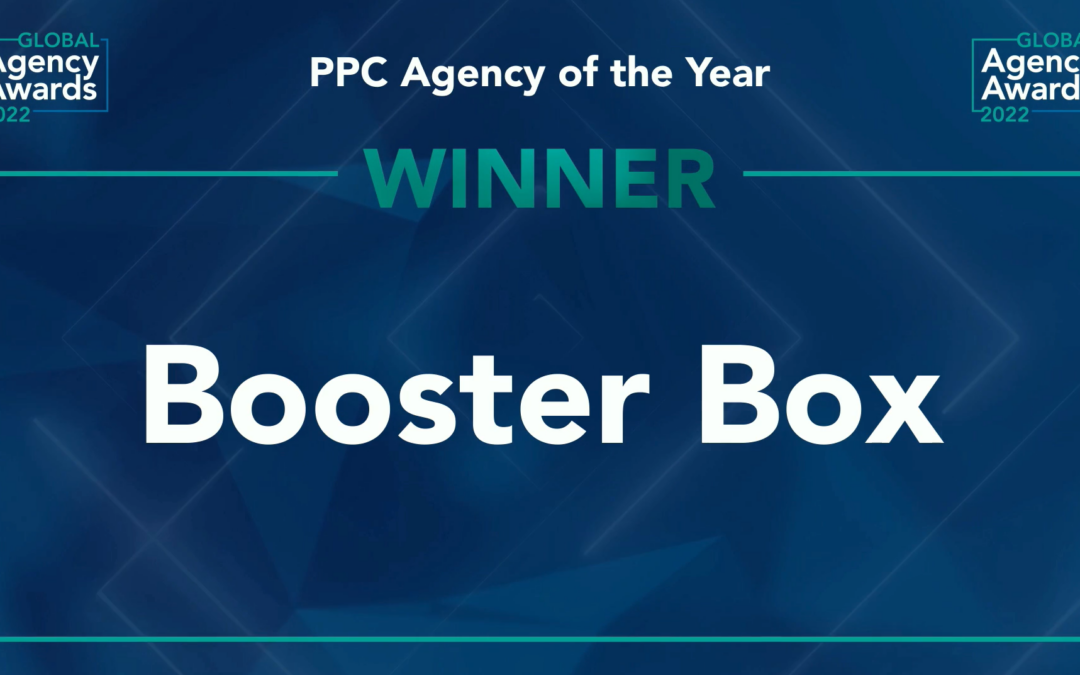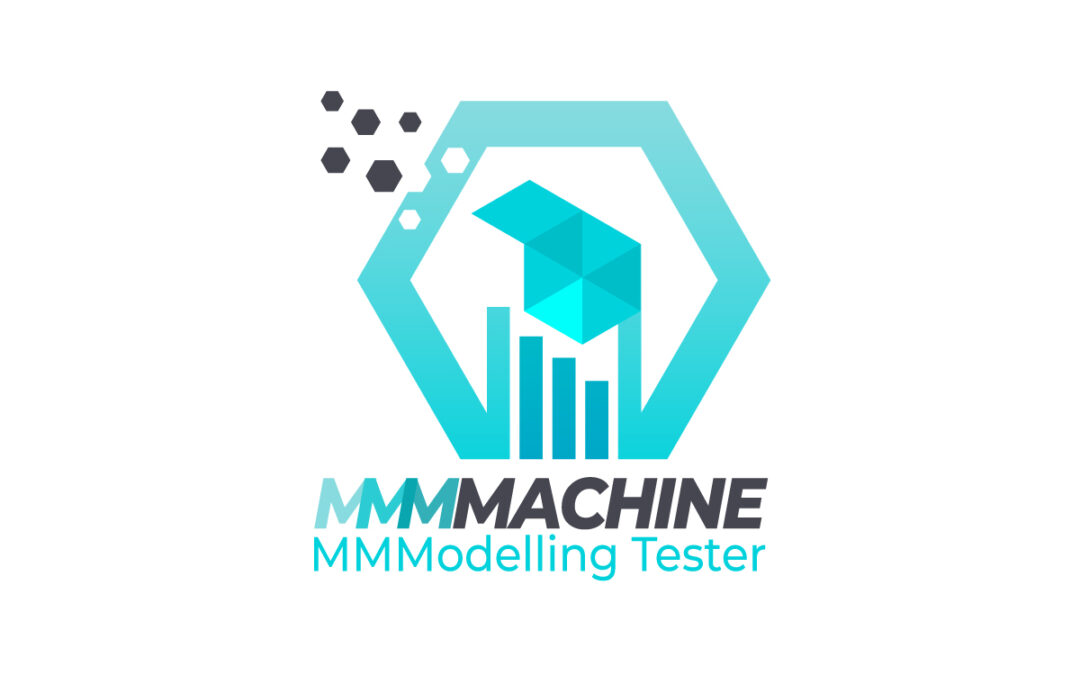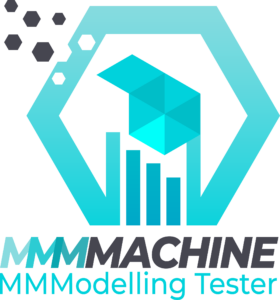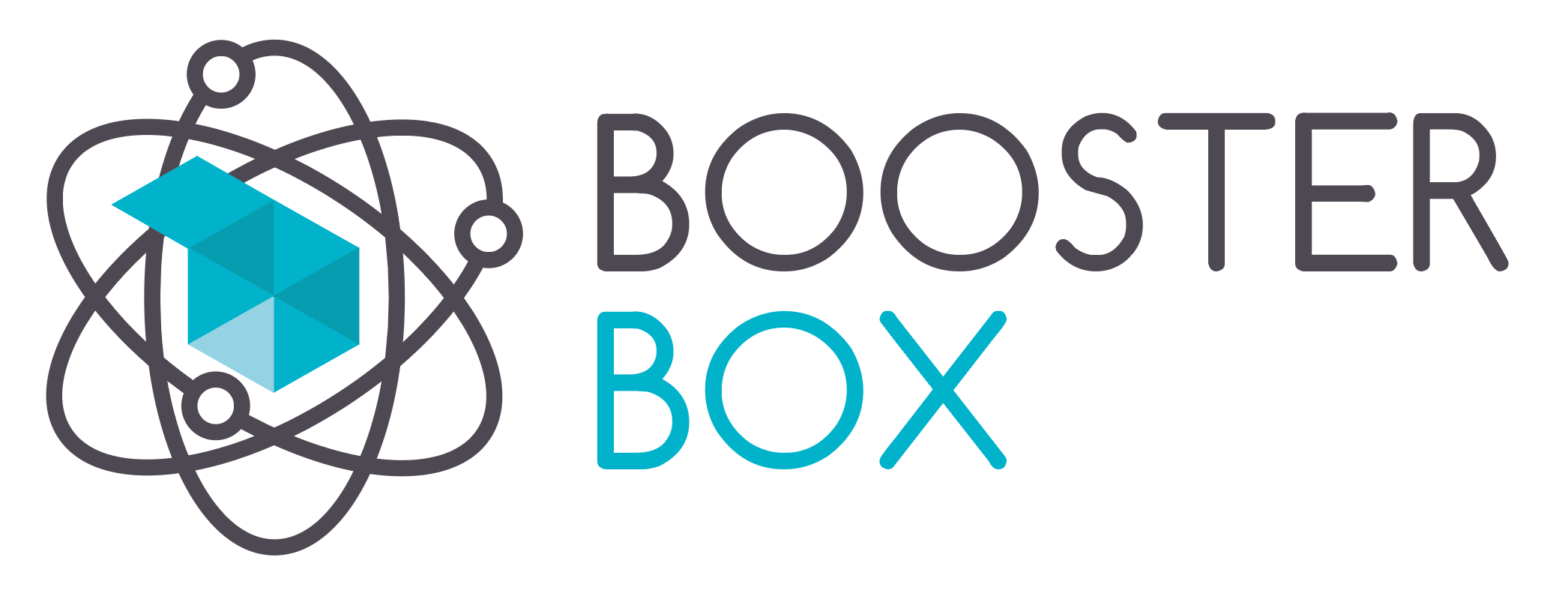
by Daniele Masiello | Jun 21, 2022 | Awards, Our News
Some will say that it is the taking part that counts, and doing your best is what matters. But nevertheless there were 5 hearts on the line at the Global Agency Awards last week and the winner was going to take it all.

We don’t usually buy into a “winner takes it all” mentality, as we value all efforts. But we guess that’s easy to say when you have just won PPC AGENCY OF THE YEAR 2022 at the Global Agency Awards of Don’t Panic Events! Judges praised our “unique solutions” that delivered positive results and big revenue accomplishments.
The Global Agency Awards recognise and reward agencies who are transforming businesses through innovative, engaging strategies across multiple types of marketing media. Judges were looking for an agency who got to know their clients’ brand and vision and created a strategy to maximise their influence and dominate the market. They always want to ensure they award the best in the business and so evaluate measurable added value and growth, impact and excellence.
Considering this criteria and our competition, it is an absolute honour for us to be acknowledged as top of the class, among the most innovative and forward-thinking agencies around the world! We are grateful that this will raise international awareness of Booster Box’s leading position in our sector. By recognising the hard work and achievements of our team, it also nurtures Boosters’ morale, improves motivation and validates our hiring stature among new recruits.

Talking about People, they really are our “secret sauce”. This achievement would have not been possible without our great team of Boosters with their strong, technical backgrounds! They lead our highly quantitative approach and enable us to provide our clients with an unfair advantage in exceptionally competitive industries where tons of data is required.
Alas, too often businesses based in non-typical locations have to deal with a trade-off where they “settle” for subpar talent and focus on local and smaller clients. Not us! We have been challenging the assumption that innovation should only be concentrated in places like London, Berlin, New York or San Francisco for the past 6 years and we won’t stop.
Since 2016 we have grown quickly and today we are a team of 66 mathematicians, developers, PPC specialists and data scientists. Furthermore and importantly we are a multicultural and diverse team, hungry for growth, made up of 40% non-Italians with a 60/40 male to female ratio.

Do you see what happens when you put 66 ambitious, happy marketers with a passion for performance marketing in one place – wherever it is? 😏

by Daniele Masiello | Jun 13, 2022 | Other Platforms, Our News, PPC Strategy
Today we are providing you with an inspirational look at our client Satispay’s success story (thanks to Incrementality). Piece of context: Satispay is a mobile app with more than 2.5 million users and the goal of simplifying their payments and their lives. As if being their Performance Marketing Agency weren’t good enough, we also won the chance to join their journey towards collecting in-app registrations across a completely new audience in the Italian market. And – icing on the cake – we even got TikTok as our shipmate!

TikTok’s the perfect mate
We ran an awareness and conversion campaign with the aim of introducing Satispay as a brand and strengthening its B2C presence across the country. On this journey, TikTok turned out to be the perfect mate for two main reasons:
- thanks to its creative tools for video editing, we used in-feed ads to deliver a cheerful native-feel video which allowed us to engage with the new audience in a personal and authentic way;
- thanks to its App Event Optimization, we were able to encourage specific audience behaviours such as app downloads, in-app events, purchases, or form completions.
Ok, now that you know the waters we navigated, we bet you would like to discover where we docked. However, let us first tell you that the destination was not unknown to us.
Incrementality testing
How could we be so confident about the outcome even before getting to it? Simple, we had planned our route extremely well. How? Elementary, My Dear Watson! Through incrementality testing.

Well, maybe not so elementary but the fact is that we’ve been sharpening our skills for it so much that it has now become easier than apple pie.
Keen to know more about this? There you go with another piece of context: measuring is becoming more and more tough and players unable to do it will likely allocate capital inefficiently. Of course, we don’t want such a thing to happen to our clients, therefore we run incrementality testing: a statistical approach that aims at estimating the causal impact of market intervention on a specific metric of interest, like sales.
The causal impact of a treatment is the difference between the observed value of the response for the treated units and the unobserved value of the response that would have been obtained under no treatment for the same treated units. Long story short: it proves that something has happened or is happening because of something else. This unobserved value is called potential outcome or counterfactual.
As our dear Dr Cooper would put it: “It’s a game we invented, it’s called “Counterfactuals”. We postulate an alternate world that differs from ours in one key aspect and then pose questions to each other. It’s fun from ages 8 to 80, join us!”
(Video to better explain the reference: https://www.youtube.com/watch?v=0lpY0Kt4bn8&t=66s)

In this specific case, we had fun measuring the impact of a new advertising platform – i.e. TikTok, of course – on Satispay’s in-app registrations in the Italian B2C market, attributing specific conversions to the channel with the precision of a fine Swiss watch.
What we need to stress here is that elementary – just kidding – measurement comes with a great variety of needs and limitations. Just to name a few: data availability, ad targeting restrictions, wide-ranging measurement objectives, budget availability and time constraints. That’s why we run geo experiments, using non-overlapping locations that are randomly, or systematically, assigned to a control or treatment condition and capable of meeting a large range of these measurement needs. For our Satispay test, for istance, we took a list of Italian cities as our treatment group and the whole of Luxembourg as the control group.
A destination (un)known
Earlier, we told you our destination wasn’t unknown but to be honest it did manage to surprise us. Our campaign proved that TikTok was able to generate 434 incremental app registrations for Satispay, exceeding our expectations with a 56% lower cost per click and a 50% lower CPA compared to previous campaigns on other platforms, while also winning a massive 347% more impressions and 123% more clicks.
We can guarantee that it felt like docking on a Caribbean island full of coconuts and free from snakes.


by Daniele Masiello | Jun 1, 2022 | Marketing Mix Modelling, Our News
Let’s start with the indisputable truth: Marketing Mix Modelling (a.k.a. MMM) makes it possible to measure past performance and chart a path for reliable, future success.

It is not just our special brain trust that says it is crucial to have a clear picture of each touchpoint’s role in a conversion, all marketing teams’ main desire is to redirect funds from inefficient channels and devote time and money to the most effective touchpoints. Isn’t this what we all dream of at night?
So let’s take a look at how we can quantify the value of marketing efforts properly and make these important decisions.

GET OVER MULTI-TOUCH ATTRIBUTION
This is a lot to process, we know, but multi-touch attribution (a.k.a. MTA) models have been proven ineffective. We have some good evidence to back this claim. Primarily, while it’s easier to imagine the customer journey as a linear path, the road to conversion is tangled, then flattened, then moulded and the action we want our customers to make, takes place somewhere in that messy-middle. Sorry MTA, we don’t want to play anymore.
As if that weren’t enough when it comes to MTA – platforms are sealed off from each other in terms of attribution and this leads to each one overestimating results to their advantage… (many of you are thinking “unfair!”, but roles reversed, you’d do the same).

AND WE THINK TO OURSELVES… WHAT A COOKIELESS WORLD
Are you still picturing that ‘messy-middle’? Good! Now add in some cookie apocalypse scenes. Tracing the real path to conversion is getting more and more complicated with updated tracking restrictions and privacy regulations. What a bloody mess!
What will we do when Google gets rid of third-party cookies in Chrome and Apple does away with access to device identifiers on iOS? Enter, MMM. Those who continue to track customer journeys only via cookies are destined to fail. Or worse, to allocate their budgets ineffectively.

THE STRUGGLE IS REAL
We’re aware marketing teams today are likely to go through blood, sweat and tears when it comes to measuring CPA, CR, ROAS, etc. whether it’s at channel or campaign level. This leads to incomplete feedback about the true value of each tactic.
Sailing in uncharted waters, cruising by sight, in the clack of night is uncomfortable (the titanic staff knows a little something about this) and impairs our ability to recognise and address channel saturation, ineffective tactics and other misfortunes like these.
Therefore, marketing teams should make ad spend decisions based on understanding of incremental value, cross-channel impacts and marginal returns.
LONG STORY SHORT
Technically speaking, Marketing Mix Modelling uses statistical analyses to measure the impact of digital marketing channels together with offline activities on sales or any other specific conversion. It can be used to forecast what is likely to happen when deploying a specific set of tactics and, given a goal, is the key to achieve the best results by re-allocating the budget to the most valuable channels.
This means Marketing Mix Modelling can help to reduce the deadweight loss by re-allocating inefficient spend to the more effective channels. Great, right?
So, how does this work?

GET A TASTE OF MARKETING MIX MODELLING
Marketing Mix Modelling is pretty complicated and needs to be calibrated by a super-technical person. It is not easy for a non-specialised team to create a Marketing Mix Model from scratch.
And we know that an interested customer in hyper-complex, beautiful things, for example a Ferrari, still likes a test drive (we’ve chosen Ferrari as an example not because we are incurable nationalists, but because we find it representative if compared to MMM).
So… at Booster Box we crafted our own test tool that creates a basic version of a Marketing Mix Model based on your data. The Tool is only a preliminary sample to take a sneak peek at the insights on your marketing mix contribution to overall performance, that you will get by embracing MMM’s service offered by Booster Box. If you want to play with the full toy, get in contact with us!
LADIES AND GENTLEMEN, WE PRESENT YOU: Marketing Mix Modelling MACHINE

After you’ve tried MMMMACHINE, we promise you will fall into the desire of getting the full, armed-to-teeth service.
TRY MMMMACHINE NOW
Get started >

by Daniele Masiello | Apr 19, 2022 | Our News, SEO
We graduated SEO college, you want to know we’re quite smart

Not to get way too personal about ourselves nor lauding our own successes (not our style), yet we thought we better let you know we love SEO and we manage it damn well.
It’s an open secret that we grew up on bread and PPC and also that dynamism, innovation and smarter ways to rock the digital world are our cup of tea. Long story short: SEO discipline fascinates us and – as we often do – we just had to master the heck out of it.
Interested in how it started and how it’s going? (Rhetorical, we know you are)

First, getting to know BERT
In 2018, Google released a search algorithm tool called BERT, aiming at a better understanding of natural language, especially when it comes to conversational search.
Designed to help solve ambiguous sentences and multiple-meaning words, BERT is also a terrific weapon when facing context challenges. By open-sourcing BERT, Google has probably changed natural language processing forever, and we’re anything but afraid.
First things first: we’re at home when it comes to welcoming changes and facing challenges. Two: while we were deepening our knowledge in its running one, Google developed a new technology to be learned anew. Guess what: nevertheless, we’re inspired with extravagant admiration. We can’t help it.

Then, loving MUM
“MUM” stands for Multitask Unified Model and it is Google’s new technology for answering complex queries. How? Being based on a deeper understanding of languages allows it to give more detailed and helpful responses.
MUM‘s main goal is indeed to make users’ searches way easier and shorter than they currently are on average. Whether searches are simple or complex, MUM will guarantee expert-level accuracy, getting different pieces of information together so as to answer multi-point questions all at once.
Thanks to its deep understanding of languages together with its broad knowledge of the world, MUM unlocks information on new paths thus providing users with the best advice it can find across the web. Upshot: fewer searches needed by users to get things done with higher accuracy.
Whilst MUM shares BERT’s architecture, it’s still said to be 1K times more powerful in understanding questions and delivering responses. Very super-smart model and despite being not operationally ready yet (it is used only internally by Google at the moment) we’re already taking inspiration from it, to develop a system capable of following MUM’s strategy in the Booster Box manner.
Our climbing strategy to the top of the SERP
Affirmative. We charted our own, original, smarter than smart (according to ourselves, our mums and our clients) way to the top of SERP that closely resembles MUM’s multi-modal approach in SERP document summarisation, sentiment analysis and topic and entity clustering.
Mission possible is: to provide our clients with MUM’s same level of efficiency.
Here’s the ingenious recipe for the magic potion, to be done on the night of a full moon:
- we undertake an extensive audit and bring forth a transparent 360-degree overview, making sure websites are built on solid foundations, barrier-free and fitted out with remarkable value in the eyes of search engines
- we run research and discovery, focusing on keywords and topics but most of all on organic competitors
- we do SERP, meta descriptions and meta titles scraping, taking the 3-5 first results and analysing them with specific tools
- we carry out text and semantic analysis for the queries we want to optimise, gathering all the best content we can find online, including links, text posts, images, and videos available on Reddit
What comes out is a brief, carefully assembled by our SEO experts on the basis of custom, proprietary tech scripts, on what competitors are doing, which keywords and their combinations would bring the highest effectiveness to description and titles and, more generally, a plan on how to optimise the keywords we want the best positioning for. This path is tied hand in glove with MUM’s goal of building deep neural networks to mimic the thinking function of the human brain by learning to recognise patterns in data.
Enticing, isn’t it?

Conclusion
We know wading through all these acronyms won’t be a piece of cake. The world of SEO has become more and more sophisticated since the early days of our industry. More sophistication = more complication, but what excites us is that these evolving tools allow us to boost our clients to the TOP of Google search queries more efficiently and transparently.
Though BERT remains a practical, heavily-tested method to put your website in front of a user, MUM is now a much-more-powerful industry standard. Therefore, granting yourself the opportunity to transition would be a savvy choice.





















